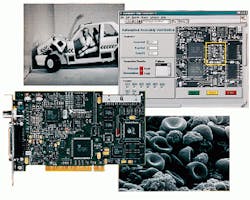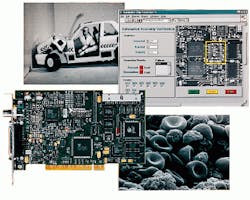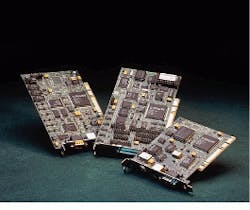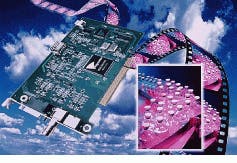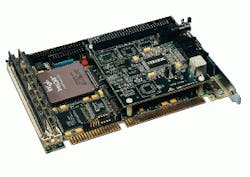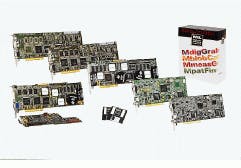CHOOSING A frame grabber FOR IMAGE-PROCESSING APPLICATIONS
CHOOSING A frame grabber FOR IMAGE-PROCESSING APPLICATIONS
By Rick Nelson, Contributing Editor
At their extremes, the memory and processor options that frame-grabber vendors offer reflect opposing philosophies of design. Companies such as Data Translation (Marlboro, MA) contend that frame grabbers should merely transfer image data to the host central processing unit (CPU) for processing and storage of image data. Such firms provide minimal on-board look-up-table (LUT) processing that is used for such functions as gamma correction.
At the other extreme, companies such as Eltec (Mainz, Germany) contend that no matter how powerful the host, it will fall short of the capabilities of dedicated image processors. Because of this, such companies populate their frame grabbers with memory and digital signal processors (DSPs) or proprietary processing modules.
Firms such as Alacron, Ariel, Dipix, Epix, Matrox, Precision Digital Images, and Truevision are using DSPs from vendors such as AT&T, Analog Devices, and Texas Instruments. Ariel (Cranbury, NJ), for example, offers boards with the Analog Devices Sharc and Texas Instruments (TI; Dallas, TX) TMS320C80 DSPs. The company is also developing board-level products based on the TI 1600-MIPS TMS320C6x DSP.
Datacube (Danvers, MA) takes a different approach, opting for dedicated pipelined processing. Company president Stan Karandanis says the company has evaluated many DSPs but the broad-bandwidth pipeline processing approach still provides the best performance for neighborhood operations such as filtering, convolution, and correlation. What`s more, he says, the pipeline approach meshes smoothly with processors such as the PowerPC. That enables the firm`s PCI-based MaxPCI and VME-based MaxVideo 250 boards to work with the company`s PowerPC-based mvPower board.
All these approaches are valid, depending on the image-processing application. If the host CPU also performs other tasks, then a frame grabber with on-board processing and memory is indispensable. But, if the desktop PC is manipulating acquired images, then no resident frame-grabber processor may be required.
Scaleable processing
Because many applications require different levels of processing, some companies offer scaleable processing on their frame-grabbers. Alacron (Nashua, NH), for example, allows a digital or analog acquisition module to be coupled to its FT-Sharc by using the company`s FastTrack expansion connectors. The FT-Sharc, in turn, can incorporate up to eight ADI2106x Sharc processors to yield nearly 1 GFLOP on a single board. Multiple GFLOPs per slot can be obtained via eight-Sharc FastTrack daughtercards. The firm also offers its FG-PCI, a PCI frame grabber that captures data to a bus-resident host processor; 32-bit-wide first-in/first-out (FIFO) buffers provide throughput rates to 132 Mbyte/s.
Frame grabbers such as the FG-PCI that place raw image data on the system bus make acquired data immediately available to the system display adapter. But such transfers of raw image data can tax bus bandwidth. That can be alleviated by on-board functions that help to control bus traffic. An on-board video graphics adapter (VGA), for example, can permit real-time display of acquired data without tying up the system bus. Alternatively, an on-board buffer can schedule system bus transfers.
MuTech (Billerica, MA) takes the VGA approach. It provides a complete VGA accelerator on its Image/ VGA-400 single-slot PCI frame grabber. Imaging Technology (Bedford, MA) takes the on-board buffer approach. Its IC-PCI image-capture board features data-transfer rates to 110 Mbyte/s to host memory over the PCI bus. Such "faster than real-time" transfer rates allow image-data transfer to take place during a host`s limited idle times.
Host processing
For its part, Data Translation favors processing images on the CPU. "Replacing the 5- to 8-Mbyte/s ISA bus with a 132-Mbyte/s PCI lets live video be streamed to a display or system memory, virtually eliminating the need for on-board memory," says product marketing manager Leslie Logan. Products relying on the PCI include Data Translation`s DT3152 and DT3155. These products can act as PCI bus masters, enabling them to initiate PCI data transfers without host intervention. Consequently, the DT3152 or DT3155 can transfer image data to a PCI video adapter and allow real-time video display while the host performs other chores.
Relying on host processing is a natural choice for National Instruments (Austin, TX), whose long-time focus has been turning PCs and workstations into virtual instruments for laboratory and production applications. The firm`s IMAQ PCI-1408 acquires monochrome NTSC and PAL video inputs and transfers digitized data to a Windows 95/NT-based PC over the PCI bus (see Fig. 1). The board includes support for the company`s real-time system-integration bus that provides synchronization with other of the company`s data-acquisition products, enabling correlation of image data with data from other events. Host-resident IMAQ Vision image-processing software enables integrators to use more than 400 imaging functions with the company`s LabVIEW, BridgeVIEW, and LabWindows graphical software packages.
Another product relying on the data-transfer capabilities of the PCI is the Coreco (St-Laurent, Que., Canada) SE Series (see Fig. 2). The SE acquires 24-bit video, transferring digital-camera output to a host processor or VGA card at 66 Mbyte/s. The company`s RGB-SE version digitizes RGB-camera video output at 24 bits; LUTs provide real-time video preprocessing.
The Imagenation (Beaverton, OR) PXC200 color frame grabber also relies on host processing and system-bus data transfers (see Fig. 3). The PCI-compatible board costs less than $400, a price point that company president George Fabel hopes will stimulate high-volume usage in manufacturing automation, medical, and scientific applications. The firm also plans to package the PXC200 in PC/104-Plus and CompactPCI form factors for embedded applications.
Not all firms believe that transfer of raw image data is the best use of bus bandwidth, and some frame-grabber companies are taking steps to minimize bus traffic. The Axon (Foster City, CA) Digidata 2000, for example, transfers only pixels within defined regions of interest to the host CPU. Says Mario Sauvageau, hardware design architect at Teknor (Boisbriand, Canada), "Moving typical full-screen live video to a display requires a bandwidth of up to 30 Mbyte/s, placing a tremendous burden on a system bus if the video has to be transferred from a PCI bus-mastering controller." Such a burden is unacceptable, he says, for the industrial applications served by Teknor`s VIPer Vision TEK-380, a PC/104 video interface modulethat mates with one of the firm`s VIPer processing boards (see Fig. 4).
Software support
When choosing frame grabbers that feature one or more processors, systems integrators should carefully evaluate available high-level development tools. Such products are supplied by both frame-grabber vendors and third parties. Io Industries (London, Ont., Canada), for example, offers packages that support the BitFlow Raptor (PCI and VESA versions), Coreco`s SE, Dipix`s Power Grabber, Epix`s 4MEGVIDEO Model 10 and 12, Imaging Technology`s IC-PCI, and MuTech`s M-Vision-1000. Io Industries products include the Eye Image Calculator 2.0, which provides general-purpose image acquisition, display, processing, and storage for Windows 3.x/95/NT.
Data Translation offers drivers and some low-level programming tools in the form of its Frame Grabber SDK, a Windows dynamic link library (DLL) that supports frame-grabber functions and memory management and camera control. The SDK supports migration to other Data Translation frame grabbers by means of the firm`s DT-Open Layers driver. Device-specific libraries handle functions, such as offset and gain selection, unique to particular products. For higher-level programming, the company suggests packages such as Integral Vision`s VisionBlox-EZ.
Similarly, Coreco supports off-the-shelf development packages that include Noesis` Visilog and Optimas` Xcaliper. Dipix (Ottawa, Canada) offers drivers for its Power Grabber imaging boards for Windows and the QNX real-time operating system from QNX Software Systems (Kanata, Ont. Canada). Used with Dipix boards, QNX provides deterministic PC response time to the Power Grabber events. The driver provides access to the Dipix Extended Vision Library, which includes image-processing functions, disk file I/O, image capture, and display.
Alacron complements its acquisition/processing-engine combinations with its real-time operating environment and application-specific libraries for imaging applications. Functions include convolution, image arithmetic image packing and unpacking, histograms, equalization, and 2-D fast Fourier tranforms. The firm also offers ANSI development tools for C and FORTRAN 77 and a graphical-user-interface-based debugger and profiler. Software portability is invaluable when moving to new hardware. Recognizing this, Alacron`s libraries operate across the firm`s line of processors.
Matrox (Dorval, Que., Canada) also recognizes the benefits of portability, adding a twist to take advantage of new hardware features. While its MIL package runs on the Meteor, Pulsar, and Genesis image-processing boards, a native library exploits features of specific processors (see Fig. 5). This native library supports functions such as hardware formatting and fine control of multiprocessor parallelism, FFT, and JPEG compression and decompression.
Although ISA-based boards will still be used for some PC applications, ISA will fade as PCI board prices fall and motherboard vendors stop offering ISA slots. And, just as PCI will displace ISA at the desktop, CompactPCI will put pressure on the VME bus for industrial applications. However, with the evolution of such standards as the VME320, the VME bus is ready to meet any speed challenges from the 132-Mbyte/s PCI architecture.
FIGURE 1. National Instruments has added the IMAQ PCI-1408 frame grabber to its line of data-acquisition products. Relying on the host CPU, the frame grabber runs applications such as LabVIEW to process acquired image data.
FIGURE 2. Transferring image data to a host or VGA adapter at 66 Mbyte/s, Coreco`s SE Series frame grabbers can acquire live video, digital camera output, or RGB signals.
FIGURE 3. Aimed at spurring high-volume usage, Imagenation`s PXC200 color frame grabber costs less than $400.
FIGURE 4. Packed in a PC/104 form factor, the Teknor TEK-380 video interface module resides on one of the firm`s VIPer Pentium CPUs to perform image-processing tasks without burdening the host processor and system bus.
FIGURE 5. To maintain portability while benefiting from new hardware features, Matrox`s MIL package runs on the firm`s Meteor, Pulsar, and Genesis image-processing boards. In addition, it offers a native library to exploit unique features of its DSP-based Genesis board.
FRAME GRABBERS-a sampling
Active Imaging l Incline Village, NV l (702) 832-0792 l Fax: (702) 832-0778
Alacron l Nashua, NH l (603) 891-2750 l Fax: (603) 891-2745 l http://www.alacron.com
American Eltec l Princeton, NJ l (609) 452-1555 l Fax: (609) 452-7374 l http://www.gifltec.com
Ariel l Cranbury, NJ l (609) 860-2900 l Fax: (609) 860-1155 l http://www.ariel.com
ASPRO Technologies Ltd. l Mississauga, Ontario, Canada l (905) 712-2131 l Fax: (905) 712-1887 l http://www.vision1.com/aspro/aspro.html
Axon Instruments Inc. l Foster City, CA l (415) 571-9400 l Fax: (415) 571-9500 l http://www.axonet.com
Bitflow Inc. l Woburn, MA l (617) 932-2900 l Fax: (617) 933-9965
Cognex l Natick, MA l (508) 650-3000 l Fax: (508) 650-3333 l http://www.cognex.com
Coreco l St. Laurent, Quebec, Canada l (514) 333-1301 l Fax: (514) 333-1388 l http://www.coreco.com
Data Translation l Marlboro, MA l (508) 481-3700 l Fax: (508) 481-8620 l http://www.datx.com
Datacube l Danvers, MA l (508) 777-4200 l Fax: (508) 777-3117 l http://www.datacube.com
Dipix Imaging Products l Ottawa, Ontario, Canada l (613) 596-4942 l Fax: (613) 596-4914 l http://www.dipix.com
DY/4 Systems Inc. l Kanata, Ontario, Canada l (613) 599-9191 l Fax: (613) 599-7777 l http://www.dy4.com
Eltec Electronik GmbH l Mainz, Germany l (6131) 918-0 l Fax: (6131) 918-197 l http://www.gifltec.com
Epix l Buffalo Grove, IL l (847) 465-1818 l Fax: (847) 465-1919 l http://www.gifpixinc.com/epix/
Imaging Technology l Bedford, MA l (617) 275-2700 l Fax: (617) 275-9590 l http://www.imaging.com
ImageNation Corp. l Beaverton, OR l (503) 641-7408 l Fax: (503) 643-2458 l http://www.imagenation.com
Imagraph l Chelmsford, MA l (508) 256-4624 l Fax: (508) 250-9155 l http://www.imagraph.com
Insync Technologies l San Leandro, CA l (510) 895-6800 l Fax: (510) 895-6899
Integral Technologies Inc. l Indianapolis, IN l (317) 845-9242 l Fax: (317) 845-9275 l http://www.integraltech.com
Matrox Imaging Products Group l Dorval, Quebec, Canada l (514) 685-2630 l Fax: (514) 685-2853 l http://www.matrox.com
MuTech Corp. l Billerica, MA l (508) 663-2400 l Fax: (508) 663-3444 l http://www.mutech.com
National Instruments l Austin, TX l (512) 794-0100 l Fax: (512) 794-8411 l http://www.natinst.com
Precision Digital Imaging l Redmond, WA l (206) 882-0218 l Fax: (206) 867-9177 l http://www.precisionimages.com
Quanta l Mountain View, CA l (415) 967-5791 l Fax: (415) 967-8762
RGB Spectrum l Alameda, CA l (510) 814-7000 l Fax: (510) 814-7026 l http://www.rgb.com
Spectrum Signal Processing l Burnaby, British Columbia, Canada l (604) 421-5422 l Fax: (604) 421-1764
Teknor l Boisbriand, Quebec, Canada l (514) 437-5682 l Fax: (514) 437-8053 l http://www.teknor.com
Truevision l Santa Clara, CA l (408) 562-4200 l Fax: (408) 562-4065 l http://www.truevision.com
Univision Technologies Inc. l Billerica, MA l (508) 670-1960 l http://www.univision.com
Ziatech l San Luis Obispo, CA l (805) 541-0488 l Fax: (805) 541-5088 l http://www.ziatech.com
